
What do the best gardens all have in common? A focal point—yes. Great plant variety—yes. But more often than not, you’ll notice that a truly beautiful landscape also has distinctive layering. This helps give a garden dimension and also makes it look lush. Layering can be done in both large and small spaces as well if you follow a few key steps. First, you need to build a compelling backbone to the bed. Then, install a diverse and varied midsection before finally adding ground covers, which provide interest at toe level. But layering—without overcrowding—is tricky. There is far more to it than simply putting tall plants in the back and short plants in the front. The following are concepts I use in my designs to get a garden that is expertly layered and filled with depth and dimension.
Learn more: Plants for a Layered-Style Garden
Use Repetition of Plants or Color
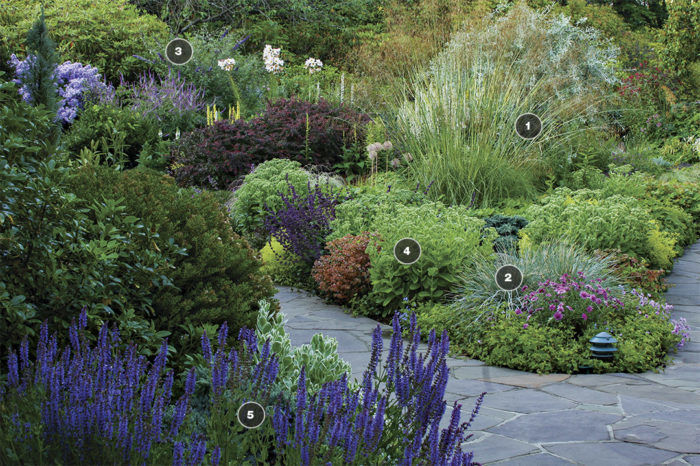
Several types and sizes of ornamental grasses and sedums are scattered throughout the layers in this area. Purple (in various shades) also helps pull things together from the back (with the towering butterfly bush) to the front (with the ‘Blue Hill’ salvia). The effect is a layered garden that is spilling over with continuity.
1. Giant feather grass (Stipa gigantea, Zones 6–9)
2. Blue oat grass (Helictotrichon sempervirens, Zones 4–8)
3. ‘Nanho Purple’ butterfly bush (Buddleia davidii* ‘Nanho Purple’, Zones 5–9)
4. ‘Autumn Joy’ sedum (Sedum ‘Autumn Joy’, Zones 4–9)
5. Blue Hill salvia (Salvia sylvestris ‘Blauhugel’, Zones 4–9)
*See invasive alert below.
Install a Sturdy, Four-Season Backbone
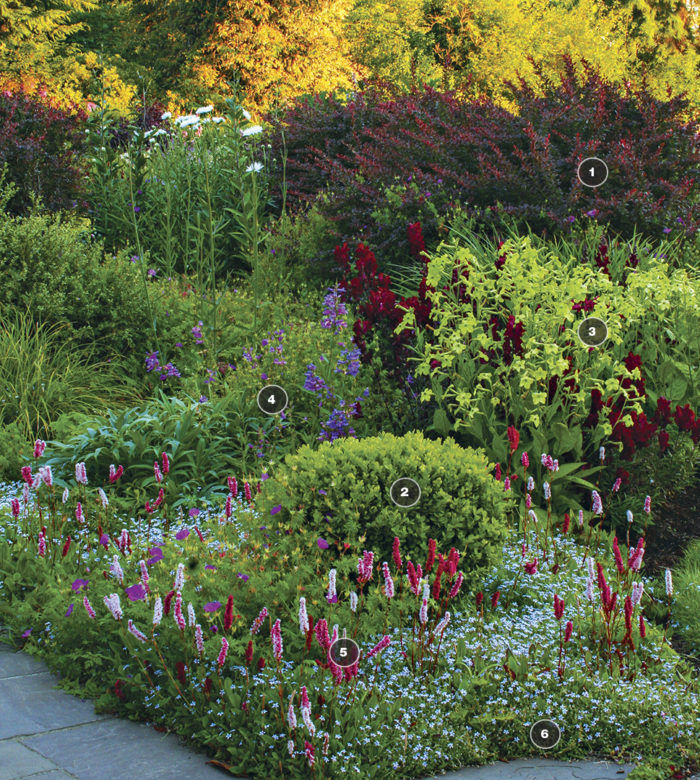
Although you might think the stand of conifers and large evergreens at the very back of this bed are the bones, it’s actually the barberry and boxwoods that give this garden its true framework. Bringing them into the heart of the bed to mingle lets them act as evergreen focal points. The surrounding perennials and annuals are purposely kept low so that the real bones can shine.
1. Purple Japanese barberry (Berberis thunbergii f. atropurpurea cv., Zones 4–9)
2. Dwarf English boxwood (Buxus sempervirens ‘Suffruticosa’, Zones 5–8)
3. ‘Limelight’ flowering tobacco (Nicotiana ‘Limelight’, annual)
4. ‘Electric Blue’ penstemon (Penstemon heterophyllus ‘Electric Blue’, Zones 6–10)
5. ‘Himalayan Border Jewel’ fleeceflower (Persicaria affinis ‘Himalayan Border Jewel’, Zones 3–8)
6. Blue star creeper (Isotoma fluviatilis, Zones 5–9)
Add Underplanting for Another Level of Interest
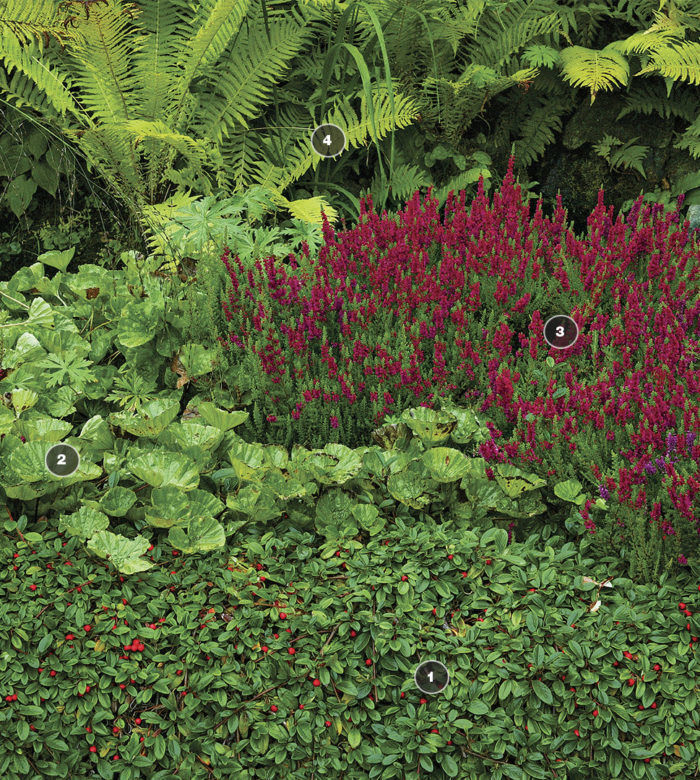
There’s no denying that the star of this area is the plant at foot level. The bearberry cotoneaster cascades over an unseen stone retaining wall while filling in underneath the creeping gunnera, which was chosen for its contrasting leaf shape. The heather adds a color to echo the red berries of the cotoneaster and contributes a feathery, evergreen, contrasting texture, while the shape of the sword fern offers more contrast in its upright form. All of this happens in just a few feet, proving that thoughtful underplanting allows layering in any size space.
1. Bearberry cotoneaster (Cotoneaster dammeri, Zones 5–8)
2. Creeping gunnera (Gunnera magellanica, Zones 7–9)
3. Scotch heather (Calluna vulgaris cv., Zones 4–9)
4. Western sword fern (Polystichum munitum, Zones 5–9)
Ensure a Mix of Shapes in the Midsection
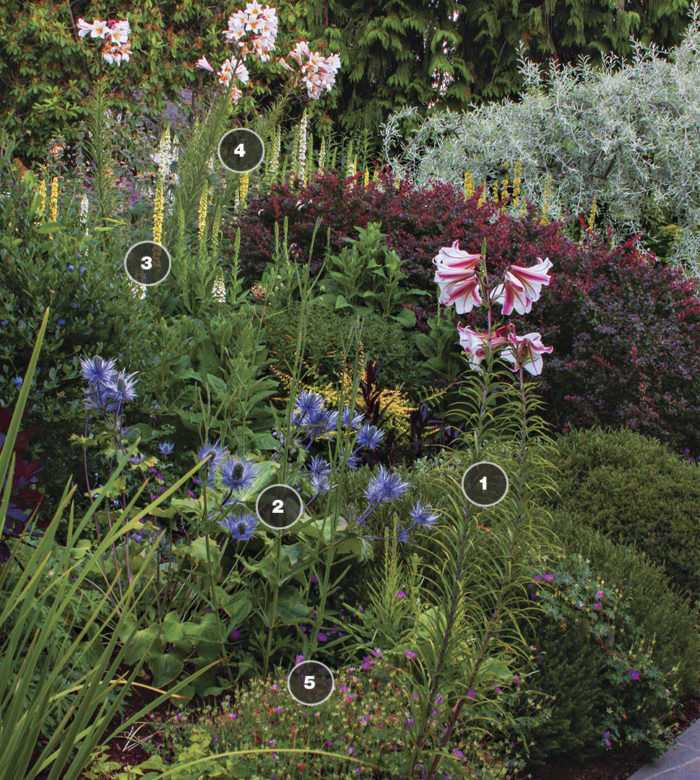
The middle doesn’t need to be filled with only modestly sized plants. Here, several tall, interestingly shaped treasures like regal lily and alpine sea holly jut out from beneath well-behaved, mounded perennials below. The effect is dramatic and eye-catching and allows more plants to be packed into the same middle region of the garden.
1. Regal lily (Lilium regale, Zones 4–8)
2. Alpine sea holly (Eryngium alpinum, Zones 2–8)
3. Nettle-leaved mullein (Verbascum chaixii, Zones 5–8)
4. Jerusalem sage (Phlomis tuberosa, Zones 6–9)
5. Bloody geranium (Geranium sanguineum, Zones 3–9)
Get the Scale Right
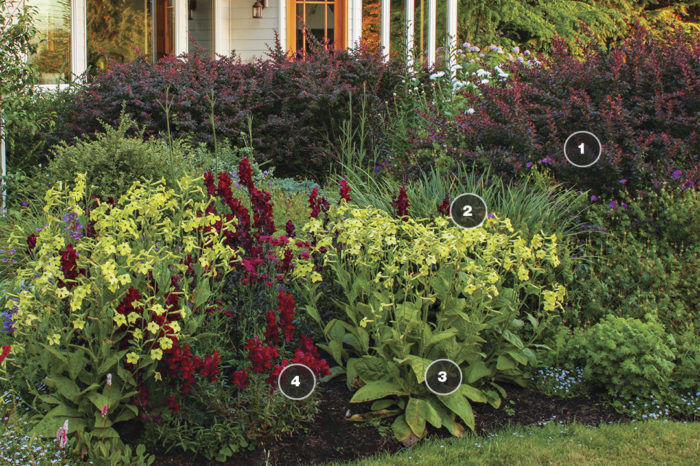
Beds surrounding a foundation can be the trickiest to layer because you don’t want plants that are too tall blocking the views. A moderately sized shrub like the barberry provides a nice backdrop that doesn’t overwhelm the single-story house. The next layer is an array of mounding perennials and annuals that are on a smaller scale in order to stay in check with the low-profile planting.
1. Purple Japanese barberry (Berberis thunbergii f. atropurpurea cv., Zones 4–9)
2. Plum-scented iris (Iris graminea, Zones 5–8)
3. ‘Limelight’ flowering tobacco (Nicotiana ‘Limelight’, annual)
4. ‘Black Prince’ snapdragon (Antirrhinum majus ‘Black Prince’, annual)
Sharon’s Top Layering Plants

I have a bevy of favorites when it comes to the best layering plants. The following are my go-to options for each section of the bed.
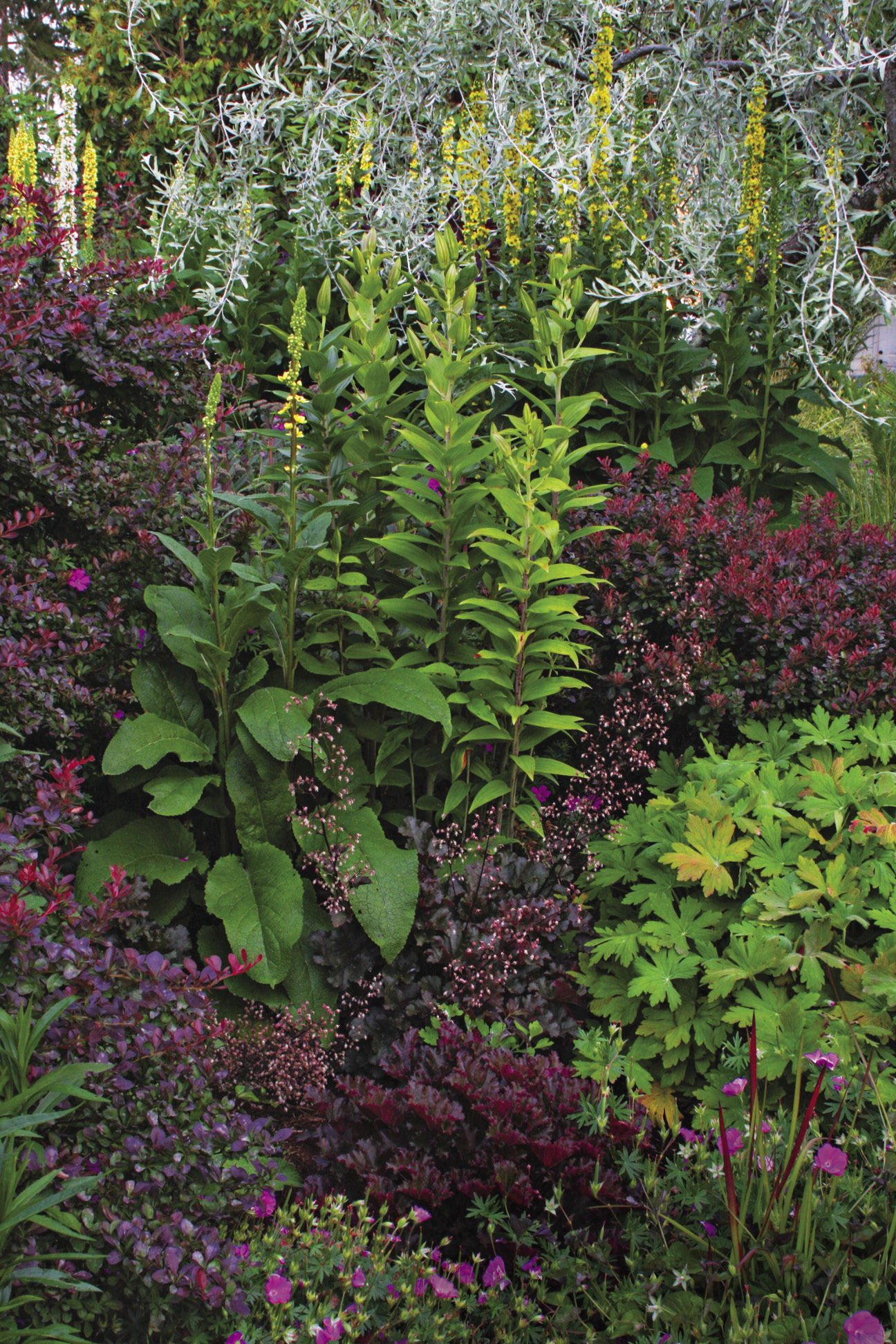
Backbone Plants

1. Joe Pye weed (Eutrochium purpureum)
Zones: 4–9
Size: 5 to 7 feet tall and 2 to 4 feet wide
Conditions: Full sun to partial shade; moist, well-drained soil
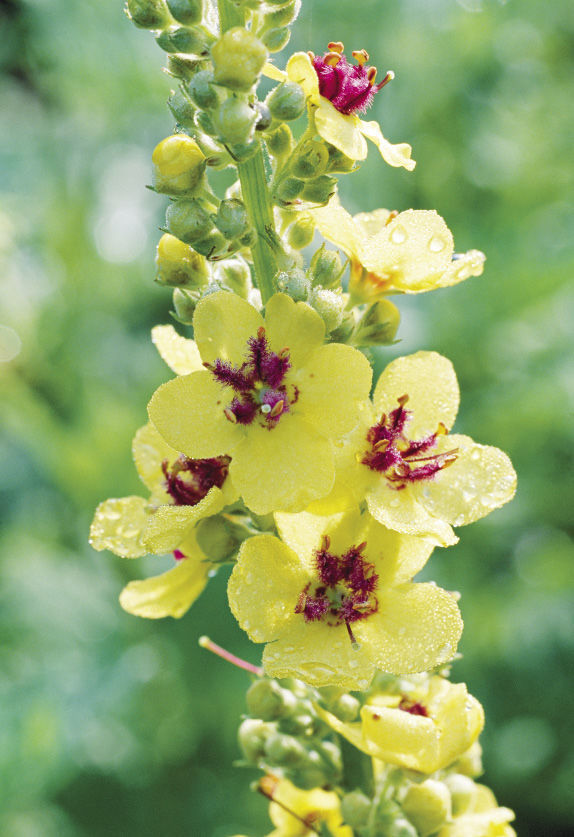 2. Nettle-leaved mullein (Verbascum chaixii)
2. Nettle-leaved mullein (Verbascum chaixii)

Zones: 5–8
Size: 3 to 4 feet tall and 1 to 2 feet wide
Conditions: Full sun; well-drained soil
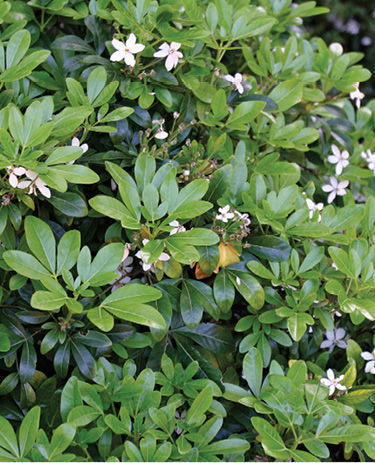 3. Mexican orange (Choisya ternata)
3. Mexican orange (Choisya ternata)

Zones: 7–10
Size: 4 to 8 feet tall and wide
Conditions: Full sun to partial shade; well-drained soil
Midsection
 4. Variegated purple moor grass
4. Variegated purple moor grass

(Molinia caerulea subsp. caerulea ‘Variegata’)
Zones: 4–9
Size: 1 to 3 feet tall and wide
Conditions: Full sun; well-drained soil
 5. ‘Brilliant’ sedum (Sedum spectabile ‘Brilliant’)
5. ‘Brilliant’ sedum (Sedum spectabile ‘Brilliant’)

Zones: 4–8
Size: 18 to 24 inches tall and wide
Conditions: Full sun; well-drained soil
 6. Monch’s aster (Aster frikartii ‘Monch’)
6. Monch’s aster (Aster frikartii ‘Monch’)

Zones: 5–10
Size: 2 to 3 feet tall and 12 to 18 inches wide
Conditions: Full sun; well-drained soil
Understory
 7. Bearberry cotoneaster (Cotoneaster dammeri)
7. Bearberry cotoneaster (Cotoneaster dammeri)

Zones: 5–8
Size: 8 to 12 inches tall and 4 to 6 feet wide
Conditions: Full sun; well-drained soil
 8. ‘Himalayan Border Jewel’ fleeceflower
8. ‘Himalayan Border Jewel’ fleeceflower

(Persicaria affinis ‘Himalayan Border Jewel’)
Zones: 6–8
Size: 6 to 8 inches tall 18 to 36 inches wide
Conditions: Full sun; moist, well-drained soil
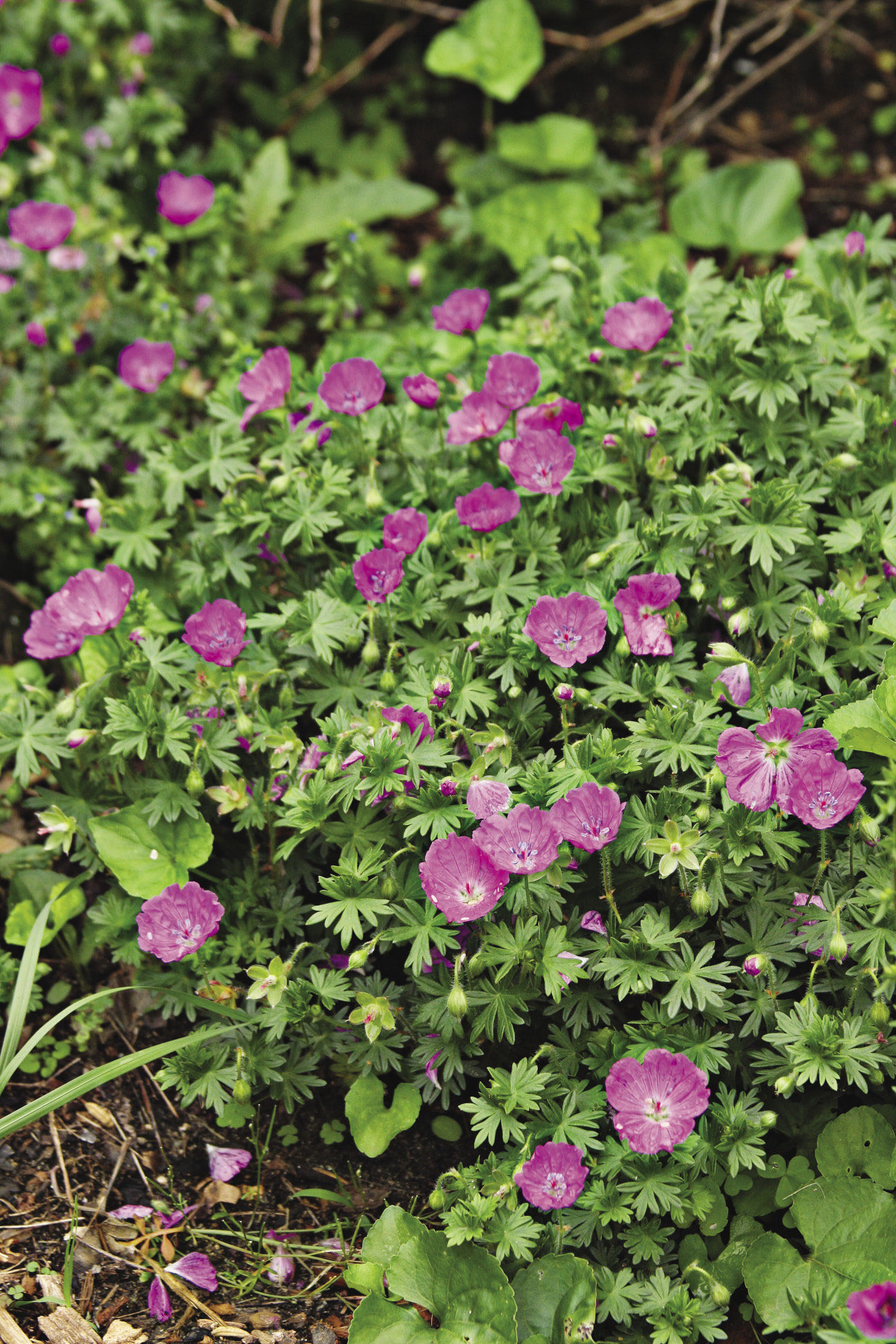 9. Bloody geranium (Geranium sanguineum)
9. Bloody geranium (Geranium sanguineum)

Zones: 3–9
Size: 8 to 12 inches tall and 1 to 2 feet wide
Conditions: Full sun; moist, well-drained soil
Sharon Nyenhuis is a garden designer in Sequim, Washington.
Photos: Danielle Sherry; Courtesy of Bruce Nyenhuis; Steve Aitken; Clive Nichols/gapphotos; Colleen Fitzpatrick; Ann E. Stratton; Kerry Ann Moore; Michelle Gervais
*Invasive alert: Butterfly bush (Buddleia davidii)
This plant is considered invasive in CA, DE, NJ, OR, TN, and WA.
Please visit invasiveplantatlas.org for more information.
Fine Gardening Recommended Products

Planting in a Post-Wild World: Designing Plant Communities for Resilient Landscapes
Fine Gardening receives a commission for items purchased through links on this site, including Amazon Associates and other affiliate advertising programs.

Scotts Cordless Grass-Shear/Shrub-Trimmer Combo
Fine Gardening receives a commission for items purchased through links on this site, including Amazon Associates and other affiliate advertising programs.
- 13.5 x 3 x 5 inches
- Uses a 7.2-Volt 2Ah high-capacity built-in lithium-ion battery; Includes a fast charger
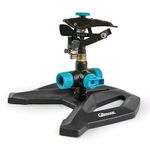
Gilmour 811673-1001 Sprinkler
Fine Gardening receives a commission for items purchased through links on this site, including Amazon Associates and other affiliate advertising programs.
- Adjustable collar for partial- to full-circle coverage
- Dial precisely sets spray distance
- On/off switch eliminates trips from sprinkler to spigot


















Comments
Log in or create an account to post a comment.
Sign up Log in